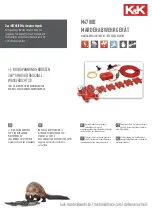
UM AX032200 Version 1.0 15-46
1.8. Math Function Block
There are four mathematical function blocks that allow the user to define basic algorithms. A math
function block can take up to six input signals. Each input is then scaled according to the
associated limit and scaling setpoints.
Inputs are converted into percentage value based on the “
Input X Minimum
” and “
Input X
Maximum
” values selected. For additional control the user can also adjust the “
Input X Decimal
Digits
” setpoint to increase the resolution of the input data and the min and max values.
A mathematical function block includes three selectable functions, in which each implements
equation
A operator B
, where A and B are function inputs and operator is function selected with a
setp
oint “
Math Function X
”. Setpoint options are presented in Table 10. The functions are
connected, so that result of the preceding function goes into Input A of the next function. Thus
Function 1 has both Input A and Input B selectable with setpoints, where Functions 2 to 4 have
only Input B selectable. Input is selected by setting “
Function X Input Y Source
” and “
Function X
Input Y Number
”. If “
Function X Input B Source
” is set to 0 ‘
Control not used’
signal goes
through function unchanged.
𝑀𝑎𝑡ℎ 𝐵𝑙𝑜𝑐𝑘 𝑂𝑢𝑡𝑝𝑢𝑡 = (((𝐴1 𝑜𝑝1 𝐵1)𝑜𝑝2 𝐵2)𝑜𝑝3 𝐵3 ) 𝑜𝑝4 𝐵4
0
=, True when InA equals InB
1
!=, True when InA not equal InB
2
>, True when InA greater than InB
3
>=, True when InA greater than or equal InB
4
<, True when InA less than InB
5
<=, True when InA less than or equal InB
6
OR, True when InA or InB is True
7
AND, True when InA and InB are True
8
XOR, True when either InA or InB is True, but not both
9
+, Result = InA plus InB
10
-, Result = InA minus InB
11
x, Result = InA times InB
12
/, Result = InA divided by InB
13
MIN, Result = Smallest of InA and InB
14
MAX, Result = Largest of InA and InB
Table 10: Math function X Operator Options
For logic operations (6, 7, and 8) scaled input greater than or equal to 1 is treated as TRUE. For
logic operations (0 to 8), the result of the function will always be 0 (FALSE) of 1 (TRUE). For the
arithmetic functions (9 to 14), it is recommended to scale the data such that the resulting operation
will not exceed full scale (0 to 100%) and saturate the output result.
When dividing, a zero divider will always result in a 100% output value for the associated function.
Lastly the resulting mathematical calculation, presented as a percentage value, can be scaled into
the appropriate physical units using the “
Math Output Minimum Range
” and “
Math Output
Maximum Range
” setpoints. These values are also used as the limits when the Math Function is
selected as the input source for another function block.
















































